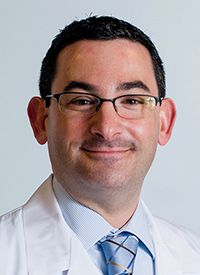Article
Brentuximab Vedotin Plus Nivolumab/Chemo Elicits 98% ORR in Early-Stage Classical Hodgkin Lymphoma
Author(s):
Frontline treatment with the combination of brentuximab vedotin, nivolumab, doxorubicin, and dacarbazine led to an overall response rate of 98% and a complete response rate of 93% in patients with early-stage, classical Hodgkin lymphoma.
Jeremy Abramson, MD

Frontline treatment with the combination of brentuximab vedotin (Adcetris), nivolumab (Opdivo), doxorubicin, and dacarbazine led to an overall response rate (ORR) of 98% (95% CI, 94.3%-99.6%) and a complete response (CR) rate of 93% (95% CI, 87.3%-96.3%) in patients with early-stage, classical Hodgkin lymphoma, according to updated findings from part C of the phase 2 SGN35-027 trial (NCT03646123).1
Data for progression-free survival (PFS) were not yet available at the time of data cutoff. The study included 154 patients, with 150 determined to be evaluable for efficacy in this assessment.
“With teens and young adults primarily impacted by Hodgkin lymphoma, our goal is to develop curative treatments that improve survival while also reducing toxicity,” Jeremy Abramson, MD, director of the Jon and Jo Ann Hagler Center for Lymphoma at Massachusetts General Hospital and principal investigator of the trial, stated in a news release. “The targeted agents of brentuximab vedotin and nivolumab have distinct mechanisms of action and demonstrated promising activity and safety in this early study; the omission of bleomycin and vinblastine chemotherapy likely contributed to the absence of certain adverse events.”
The open-label, non-randomized phase 2 trial enrolled patients at least 12 years of age (in the United States) or at least 18 years of age (regions outside the United States) with histologically confirmed, treatment-naïve, classic Hodgkin lymphoma who had Ann Arbor Stage III or IV disease (part A); Ann Arbor Stage I or II disease with bulky mediastinal disease, or Stage III or IV disease (part B); or Ann Arbor Stage I or II disease without bulky disease (part C).2 Patients were also required to have bidimensional measurable disease per PET/CT or CT imaging and an ECOG performance status of 0 to 2.
Key exclusion criteria included nodular lymphocyte predominant Hodgkin lymphoma; a history of another malignancy within 3 years study treatment or any evidence of residual disease from a previously diagnosed malignancy; prior immunosuppressive chemotherapy, therapeutic radiation, or any immunotherapy within 4 weeks of first study treatment; or prior treatment with an anti–PD-1, anti–PD-L1, anti–PD-L2, or anti–CTLA-4 antibody.
Patients in parts B and C received 1.2 mg/kg of intravenous (IV) brentuximab vedotin, 240 mg of IV nivolumab, 25 mg/m2 of IV doxorubicin, and 375 mg/m2 of IV dacarbazine. Treatment lasted for 6 cycles in part B and 4 cycles in part C. Treatment in part A consisted of 1.2 mg/kg of IV brentuximab vedotin, 25 mg/m2 of IV doxorubicin, and 375 mg/m2 of IV dacarbazine, 6 mg/m2 of IV vinblastine, and granulocyte colony–stimulating factor for 6 cycles.
CR rate served as the primary end point in parts B and C, and rate of febrile neutropenia was the primary end point in part A. Secondary end points for parts B and C included safety, lab abnormalities, duration of response (DOR), duration of CR (DOCR), event-free survival, PFS, and overall survival.
Regarding safety in part C, the most common any-grade treatment-related adverse effects (TRAEs) reported in more than 30% of patients included nausea (65%), peripheral sensory neuropathy (47%) and fatigue (44%). The rate of grade 3 or higher peripheral sensory neuropathy was 3%, and no instances of febrile neutropenia were reported.1
Findings for immune-mediated AEs were consistent with the individual safety profile of nivolumab. No grade 5 AEs occurred.
Updated data from part B of the study presented at the 2023 EHA Congress showed that at a median follow-up of 18.8 months (95% CI, 17.9-22.5), patients treated with brentuximab vedotin plus nivolumab and chemotherapy (n = 57) experienced estimated 12- and 18-month PFS rates of 95% and 93%, respectively. The ORR was 95% (95% CI, 85.1%-98.9%), including a CR rate of 89% (95% CI, 78.1%-96.0%).3 The median DOR and DOCR was not yet reached. Notably, 86% (95% CI, 71.2%-93.9%) and 88% (95% CI, 75.8%-94.6%) of patients, respectively, had a DOR and DOCR lasting for at least 18 months.
The most common any-grade TRAEs in part B consisted of nausea (65%), fatigue (49%), peripheral sensory neuropathy (44%), and alopecia (35%). Other any grade TRAEs occurring in more than 10% of patients included diarrhea (30%), constipation (26%), increased alanine aminotransferase (ALT; 16%), headache (16%), vomiting (16%), bone pain (14%), stomatitis (14%), increased aspartate aminotransferase (AST; 12%), reduced appetite (12%), myalgia (12%), maculopapular rash (12%), dyspepsia (11%), and neutropenia (11%).
The most common grade 3 or higher TRAEs included increased ALT (11%), neutropenia (9%), fatigue (4%), peripheral sensory neuropathy (4%), increased AST (4%), colitis (4%), anemia (4%), pneumonitis (4%), and pyrexia (4%).
References
- Seagen announces Adcetris (brentuximab vedotin) plus novel immunotherapy combination delivers 98% overall response rate and 93% complete response rate in patients with early-stage classical Hodgkin lymphoma (cHL). News release. Seagen. June 13, 2023. Accessed June 13, 2023. https://investor.seagen.com/press-releases/
- Clinical trial of brentuximab vedotin in classical Hodgkin lymphoma. ClinicalTrials.gov. Updated December 6, 2022. Accessed June 13, 2023. https://clinicaltrials.gov/ct2/show/NCT03646123
- Yasenchak CA, Flinn IW, Melear J, et al. Brentuximab vedotin, nivolumab, doxorubicin, and dacarbazine (AN+AD) for advanced-stage classical Hodgkin lymphoma: updated efficacy and safety results from the single-rm phase 2 study (SGN35-027 part B). Presented at: 2023 EHA Congress; June 7-11, 2023; Frankfurt, Germany. Abstract P1130.









